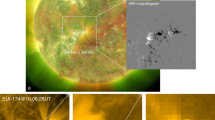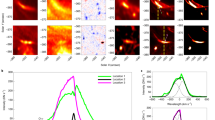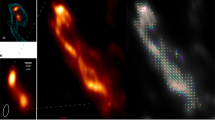Abstract
Solar X-ray jets are thought to be made by a burst of reconnection of closed magnetic field at the base of a jet with ambient open field1,2. In the accepted version of the ‘emerging-flux’ model, such a reconnection occurs at a plasma current sheet between the open field and the emerging closed field, and also forms a localized X-ray brightening that is usually observed at the edge of the jet’s base1,3. Here we report high-resolution X-ray and extreme-ultraviolet observations of 20 randomly selected X-ray jets that form in coronal holes at the Sun’s poles. In each jet, contrary to the emerging-flux model, a miniature version of the filament eruptions that initiate coronal mass ejections4,5,6,7 drives the jet-producing reconnection. The X-ray bright point occurs by reconnection of the ‘legs’ of the minifilament-carrying erupting closed field, analogous to the formation of solar flares in larger-scale eruptions. Previous observations have found that some jets are driven by base-field eruptions8,9,10,11, but only one such study, of only one jet, provisionally questioned the emerging-flux model12. Our observations support the view that solar filament eruptions are formed by a fundamental explosive magnetic process that occurs on a vast range of scales, from the biggest mass ejections and flare eruptions down to X-ray jets, and perhaps even down to smaller jets that may power coronal heating10,13,14. A similar scenario has previously been suggested, but was inferred from different observations and based on a different origin of the erupting minifilament15.
This is a preview of subscription content, access via your institution
Access options
Subscribe to this journal
Receive 51 print issues and online access
$199.00 per year
only $3.90 per issue
Buy this article
- Purchase on Springer Link
- Instant access to full article PDF
Prices may be subject to local taxes which are calculated during checkout


Similar content being viewed by others
Change history
22 July 2015
The dates in Extended Data Table 1 were updated.
References
Shibata, K. et al. Observations of x-ray jets with the Yohkoh soft x-ray telescope. Publ. Astron. Soc. Jpn. 44, 173L–179L (1992)
Cirtain, J. W. et al. Evidence for Alfvén waves in solar jets. Science 318, 1580–1582 (2007)
Yokoyama, T. & Shibata, K. Magnetic reconnection as the origin of x-ray jets and Hα surges on the sun. Nature 375, 42–44 (1995)
Hirayama, T. Theoretical model of flares and prominences. Sol. Phys. 34, 323–338 (1974)
Shibata, K. et al. Hot-plasma ejections associated with compact-loop solar flares. Astrophys. J. 451, L83–L85 (1995)
Moore, R. L., Sterling, A. C., Hudson, H. S. & Lemen, J. Onset of the magnetic explosion in solar flares and coronal mass ejections. Astrophys. J. 552, 833–848 (2001)
Chen, P. F. Coronal mass ejections: models and their observational basis. Living Rev. Sol. Phys 8, 1–92 (2011)
Moore, R. L., Tang, F., Bohlin, J. D. & Golub, L. H-alpha macrospicules—identification with EUV macrospicules and with flares in x-ray bright points. Astrophys. J. 218, 286–290 (1977)
Hong, J. et al. Coronal bright points associated with minifilament eruptions. Astrophys. J. 796, 73 (2014)
Raouafi, N. -E., Georgoulis, M. K., Rust, D. M. & Bernasconi, P. N. Micro-sigmoids as progenitors of coronal jets: is eruptive activity self-similarly multi-scaled? Astrophys. J. 718, 981–987 (2010)
Nisticò, G., Bothmer, V., Patsourakos, S. & Zimbardo, G. Characteristics of EUV coronal jets observed with STEREO/SECCHI. Sol. Phys. 259, 87–108 (2009)
Adams, M., Sterling, A. C., Moore, R. L. & Gary, G. A. A small-scale eruption leading to a blowout macrospicule jet in an on-disk coronal hole. Astrophys. J. 783, 11 (2014)
Moore, R. L., Sterling, A. C., Falconer, D. A. & Robe, D. The cool component and the dichotomy, lateral expansion, and axial rotation of solar x-ray jets. Astrophys. J. 769, 134 (2013)
De Pontieu, B. et al. The origins of hot plasma in the solar corona. Science 331, 55–58 (2011)
Shibata, K. Evidence of magnetic reconnection in solar flares and a unified model of flares. Astrophys. Space Sci. 264, 129–144 (1999)
Shimojo, M. et al. Statistical study of solar x-ray jets observed with the Yohkoh soft x-ray telescope. Publ. Astron. Soc. Jpn. 48, 123–136 (1996)
Savcheva, A. et al. A study of polar jet parameters based on Hinode XRT observations. Publ. Astron. Soc. Jpn. 59, S771–S778 (2007)
Nishizuka, N. et al. Giant chromospheric anemone jet observed with Hinode and comparison with magnetohydrodynamic simulations: evidence of propagating Alfvén waves and magnetic reconnection. Astrophys. J. 683, L83–L86 (2008)
Moreno-Insertis, F. & Galsgaard, K. Plasma jets and eruptions in solar coronal holes: a three-dimensional flux emergence experiment. Astrophys. J. 771, 20 (2013)
Archontis, V. & Hood, A. W. A numerical model of standard to blowout jets. Astrophys. J. 769, L21 (2013)
Fang, F., Fan, Y. & McIntosh, S. W. Rotating solar jets in simulations of flux emergence with thermal conduction. Astrophys. J. 789, L19 (2014)
Kosugi, T. et al. The Hinode (solar-B) mission: an overview. Sol. Phys. 243, 3–17 (2007)
Lemen, J. R. et al. The atmospheric imaging assembly (AIA) on the solar dynamics observatory (SDO). Sol. Phys. 275, 17–40 (2012)
Sterling, A. C. & Moore, R. L. Internal and external reconnection in a series of homologous solar flares. J. Geophys. Res. 106, 25227–25238 (2001)
Sterling, A. C. & Moore, R. L. Slow-rise and fast-rise phases of an erupting solar filament, and flare emission onset. Astrophys. J. 630, 1148–1159 (2005)
Bernasconi, P. N., Rust, D. D. M. & Hakim, D. Advanced automated solar filament detection and characterization code: description, performance, and results. Sol. Phys. 228, 97–117 (2005)
Wang, J. et al. Minifilament eruption on the quiet sun. I. Observations at Hα central line. Astrophys. J. 530, 1071–1084 (2000)
Savcheva, A., Cirtain, J. W., DeLuca, E. E. & Golub, L. Does a polar coronal hole’s flux emergence follow a Hale-like law? Astrophys. J. 702, L32–L36 (2009)
Shen, Y., Liu, Y., Su, J. & Deng, Y. On a coronal blowout jet: the first observation of a simultaneously produced bubble-like CME and a jet-like CME in a solar event. Astrophys. J. 745, 164 (2012)
Young, P. R. & Muglach, K. A. Solar dynamics observatory and Hinode observations of a blowout jet in a coronal hole. Sol. Phys. 289, 3313–3329 (2014)
Crooker, N. U., Gosling, J. T. & Kahler, S. W. Reducing heliospheric magnetic flux from coronal mass ejections without disconnection. J. Geophys. Res. 107, 1028–1032 (2002)
Freeland, S. L. & Handy, B. N. Data analysis with the SolarSoft system. Sol. Phys. 182, 497–500 (1998)
Moore, R. L., Cirtain, J. W., Sterling, A. C. & Falconer, D. A. Dichotomy of solar coronal jets: standard jets and blowout jets. Astrophys. J. 720, 757–770 (2010)
Sterling, A. C., Moore, R. L. & Freeland, S. L. Insights into filament eruption onset from Solar Dynamics Observatory observations. Astrophys. J. 731, L3 (2011)
Shibata, K. et al. Chromospheric anemone jets as evidence of ubiquitous reconnection. Science 318, 1591–1594 (2007)
Innes, D. & Teriaca, L. Quiet sun explosive events: jets, splashes, and eruptions. Sol. Phys. 282, 453–469 (2013)
Shibata, K. & Tanuma, S. Plasmoid-induced-reconnection and fractal reconnection. Earth Planets Space 53, 473–482 (2001)
Lin, J., Forbes, T. G. & Isenberg, P. A. Prominence eruptions and coronal mass ejections triggered by newly emerging flux. J. Geophys. Res. 106, 25053–25074 (2001)
Kusano, K. et al. Magnetic field structures triggering solar flares and coronal mass ejections. Astrophys. J. 760, 31 (2012)
Chandrashekhar, K., Morton, R. J., Banerjee, D. & Gupta, G. R. The dynamical behaviour of a jet in an on-disk coronal hole observed with AIA/SDO. Astron. Astrophys. 562, A98 (2014)
Innes, D. E., Genetelli, A., Atie, R. & Potts, H. E. Quiet Sun mini-coronal mass ejections activated by supergranular flows. Astron. Astrophys. 495, 319–323 (2009)
Schrijver, C. J. Eruptions from solar ephemeral regions as an extension of the size distribution of coronal mass ejections. Astrophys. J. 710, 1480–1485 (2010)
Liu, C., Deng, N., Liu, R., Ugarte-Urra, I., Wang, S. & Wang, H. A standard-to-blowout jet. Astrophys. J. 735, L18 (2011)
Huang, Z., Madjarska, M. S., Doyle, J. G. & Lamb, D. A. Coronal hole boundaries at small scales. IV. SOT view. Magnetic field properties of small-scale transient brightenings in coronal holes. Astron. Astrophys. 548, A62–A80 (2012)
Pariat, E., Antiochos, S. K. & De Vore, C. R. A model for solar polar jets. Astrophys. J. 74, 61–74 (2009)
Acknowledgements
A.C.S. and R.L.M. were supported by funding from the Heliophysics Division of NASA’s Science Mission Directorate through the Living With A Star Targeted Research and Technology Program (LWS TR&T), and the Hinode Project. Both benefited from TR&T discussions and from discussions with S. K. Antiochos. We thank D. M. Zarro for assistance with video development. A.C.S. benefited from discussions held at the International Space Science Institute (ISSI; Switzerland) International Team on Solar Coronal Jets (led by N. Raouafi). Hinode is a Japanese mission developed and launched by the Institute of Space and Astronautical Science (ISAS) of the Japan Aerospace Exploration Agency (JAXA), with the National Astronomical Observatory Japan (NAOJ) as a domestic partner, and NASA and the Science and Technology Facilities Council (UK) as international partners. It is operated by these agencies in cooperation with the European Space Agency and Norwegian Space Agency.
Author information
Authors and Affiliations
Contributions
A.C.S. carried out the reduction, analysis, and interpretation of XRT and AIA data, software development, and manuscript preparation. R.L.M. interpreted the results and reviewed the manuscript. D.A.F. developed software, and assimilated and calibrated AIA data. M.A. discovered and analysed the seminal jet event that motivated this broader investigation, and carried out manuscript formatting and review.
Corresponding authors
Ethics declarations
Competing interests
The authors declare no competing financial interests.
Extended data figures and tables
Extended Data Figure 1 Emerging-flux model for the formation of solar X-ray jets.
The commonly accepted mechanism for jet formation1. Black lines represent magnetic field, with arrows indicating polarity; the yellow curve is the solar limb; the thick red curve in a represents a plasma current sheet; the red cross in b shows the location of field reconnection. a, Initial state. b, Jet formation: flux emergence purportedly forces reconnection at the current sheet (red cross), resulting in new closed-loop field (red loop), and new connections to the open coronal field (thin red line), along which the X-ray jet (purple) flows. According to this model, the new reconnection loops appear as the JBP. Previous scenarios for ‘blowout jets’13,33,45 have been variations of this model.
Extended Data Figure 2 Jet of 2010 September 9, 22 ut.
a–c, XRT, and d–f, 193-Å AIA images of the jet. Arrows show: b, the developing JBP; c, the X-ray-jet spire; and d, the minifilament. In e, both arrows point to segments of the minifilament, which split during eruption; in f, both arrows point to the edges of a broad jet. In d, the blue bar shows our estimate of the size of the minifilament, the value of which appears in Extended Data Table 1. See Supplementary Video 2 for animations. This is event 12 of Extended Data Table 1. North is to the top and west to the right of these images (and all other solar images in this paper).
Extended Data Figure 3 Jet of 2010 September 9, 23 ut.
a–c, XRT, and d–f, 211-Å AIA images of the jet. Arrows show: b, the developing JBP; c, the X-ray-jet spire; and d, the minifilament starting to erupt. The blue bar in d shows our estimate of the size of the minifilament. The AIA images show a smaller field of view than the XRT images. See Supplementary Video 3 for animations. This is event 13 of Extended Data Table 1.
Extended Data Figure 4 Jet of 2010 August 28, 13 ut.
a–c, XRT, and d–f, 304-Å AIA images of a ‘standard’ jet. Arrows show: b, the X-ray jet spire; c, the X-ray jet spire, showing drift since b; d, the minifilament starting to erupt; e, ‘rolling’ filament (see Methods). The blue bar in d shows our estimate of the size of the minifilament. The grey-scale images show the filament better than the colour images for this event. See Supplementary Video 4 for animations. This is event 7 of Extended Data Table 1.
Extended Data Figure 5 Jet of 2010 August 28, 11 ut.
a–c, XRT, and d–f, 211-Å AIA images of a ‘standard’ jet. The dark spot northwest of centre in the XRT images is an artefact. Arrows show: b, the JBP; c, the X-ray jet spire; d, the minifilament moving upwards; e, the minifilament near the apex of the jet base, with the jet spire starting to develop. The AIA images show a smaller field of view than the XRT images. The blue bar in d shows our estimate of the size of the minifilament. See Supplementary Video 5 for animations. This is event 6 of Extended Data Table 1.
Supplementary information
Erupting-Jet Example (Figure 1)
Jet in soft X-rays from Hinode/XRT (left) and EUV from SDO/AIA 193 Å (right). The videos are synced to approximately concurrent times. See discussion in the text, and Figure 1 and corresponding legend, for details of the jet. This is event 18 of Extended Data Table 1. (MOV 9678 kb)
Jet of 2010 September 9, 22 UT (Extended Data Figure 2)
XRT (left) and AIA 193 Å (right) video of the jet. The videos are synced to approximately concurrent times. See Extended Data Figure 2 and corresponding legend for details of the jet. This is event 12 of Extended Data Table 1. (MOV 10881 kb)
Jet of 2010 September 9, 23 UT (Extended Data Figure 3)
XRT (left) and AIA 211 Å (right) videos of the jet. The videos are synced to approximately concurrent times. AIA images are zoomed-in more than are the XRT images. See Extended Data Figure 3 and corresponding legend for details of the jet. This is event 13 of Extended Data Table 1. (MOV 7637 kb)
Jet of 2010 August 28, 13 UT (Extended Data Figure 4)
XRT (left) and AIA 304 Å (right) video of a “standard” jet. See Extended Data Figure 4 and corresponding legend for details of the jet. This is event 7 of Extended Data Table 1. (MOV 11999 kb)
Jet of 2010 August 28, 11 UT (Extended Data Figure 5)
XRT (left) and AIA 211 Å (right) video of a “standard” jet. Dark spot north-west of center in XRT images is an artifact. AIA images are zoomed-in more than are the XRT images. See Extended Data Figure 5 and corresponding legend for details of the jet. This is event 6 of Extended Data Table 1. (MOV 7480 kb)
PowerPoint slides
Rights and permissions
About this article
Cite this article
Sterling, A., Moore, R., Falconer, D. et al. Small-scale filament eruptions as the driver of X-ray jets in solar coronal holes. Nature 523, 437–440 (2015). https://doi.org/10.1038/nature14556
Received:
Accepted:
Published:
Issue Date:
DOI: https://doi.org/10.1038/nature14556
This article is cited by
-
Circular-ribbon flares and the related activities
Reviews of Modern Plasma Physics (2024)
-
Ultra-high-resolution observations of persistent null-point reconnection in the solar corona
Nature Communications (2023)
-
Rapid Rotation of an Erupting Prominence and the Associated Coronal Mass Ejection on 13 May 2013
Solar Physics (2023)
-
Parker Solar Probe: Four Years of Discoveries at Solar Cycle Minimum
Space Science Reviews (2023)
-
Defining the Middle Corona
Solar Physics (2023)
Comments
By submitting a comment you agree to abide by our Terms and Community Guidelines. If you find something abusive or that does not comply with our terms or guidelines please flag it as inappropriate.



